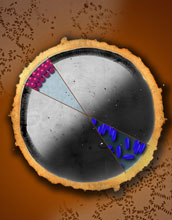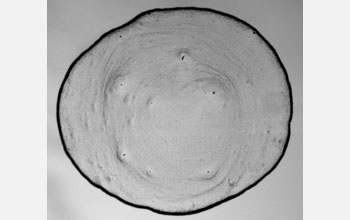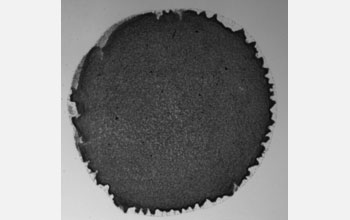All Images
News Release 11-166
The Future of Inks, Paints and Coatings Takes Shape
Researchers determine that particle shape affects the 'coffee ring effect'
This material is available primarily for archival purposes. Telephone numbers or other contact information may be out of date; please see current contact information at media contacts.

This illustration represents a how a dried drop would appear if it contained round particles (red) or elongated particles (blue).
When a drop of coffee or tea dries, its particles (which are round) leave behind a ring-like stain called the "coffee ring effect" (upper left). But if you change the shape of the particles, the coffee stain behavior changes too. Elongated particles (blue) do not exhibit the coffee ring effect, rather they are deposited across the entire area of the drop, resulting in a uniformly dark stain (lower right).
Credit: Felice Macera, University of Pennsylvania
Download the high-resolution JPG version of the image. (4.5 MB)
Use your mouse to right-click (Mac users may need to Ctrl-click) the link above and choose the option that will save the file or target to your computer.
When a drop of liquid containing round particles evaporates, it leaves behind a ring-like stain called the coffee ring effect.
As liquid evaporates, fluid flows outward from the middle of the droplet to its edges, carrying particles to the edges. Round particles at the edge pack closely, producing the coffee ring effect.
But if you change the shape of the particles, the coffee stain behavior changes too. Elongated particles do not exhibit the coffee ring effect; rather, they are deposited across the entire area of the drop.
Instead of flowing to and piling up near the edges, the elongated particles deform the droplet surface, which in turn causes them to clump all over the droplet surface.
Clumps are loosely-packed and eventually spread towards the middle of the drop.
Adding surfactant--soap--also changes how the particles interact with the surface.
In this case, the elongated particles plus surfactant behave more like round particles and pack in a ring at the edge of the drop.
Credit: Kurtis Sensenig, University of Pennsylvania

When a drop of coffee or tea dries, its particles (which are round) are deposited in a ring-like shape at the edge of the drop.
Credit: Peter J. Yunker and Arjun G. Yodh, University of Pennsylvania
Download the high-resolution JPG version of the image. (119 KB)
Use your mouse to right-click (Mac users may need to Ctrl-click) the link above and choose the option that will save the file or target to your computer.

Elongating the shape of the particles in the droplet changes the way they distribute themselves within the liquid. Elongated or ellipsoidal particles form clumps that will eventually spread to cover the entire surface of the droplet, filling it so an even coating of particles is deposited when evaporation is complete.
Credit: Peter J. Yunker and Arjun G. Yodh, University of Pennsylvania
Download the high-resolution JPG version of the image. (106 KB)
Use your mouse to right-click (Mac users may need to Ctrl-click) the link above and choose the option that will save the file or target to your computer.
